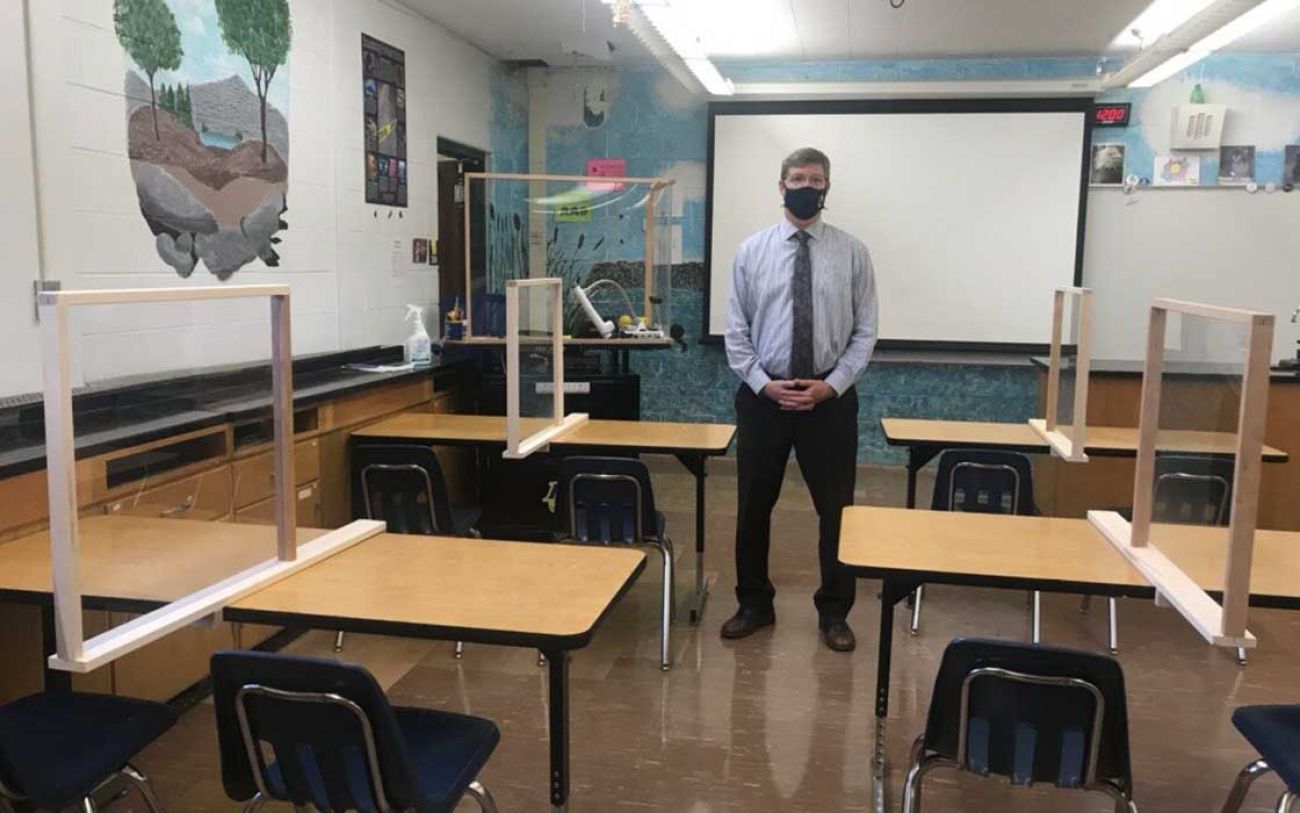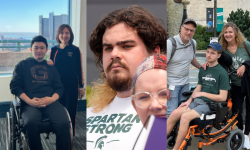Why it still matters whether Michigan K-12 students contract COVID

When Michigan school districts forged plans this fall to open classrooms to students, there was little question it would lead to some spread of COVID-19. The question was: How much? And would it be manageable?
More than six weeks into the school year, the answer, so far, falls somewhere between no problem and a raging wildfire.
There are currently 435 confirmed coronavirus cases connected to outbreaks at 84 K-12 schools, according to a state report released Monday.
But what do those numbers mean? Are they cause for panic, or relief? And do the numbers much matter, given that only a small fraction of young people have serious complications in the pandemic?
Bridge Michigan answers some basic questions on school COVID outbreaks that readers have posed to us.
Related:
- Michigan coronavirus unemployment, map, curve, COVID-19 updates
- Dashboard: Michigan coronavirus testing numbers, trends, COVID-19 data
Is 435 cases a lot?
There are about 1.5 million students in the state’s public K-12 schools and nearly 350,000 teachers and staff. Add in the 100,000 or so students in private K-12 education and the staff in those schools, and that makes about 2 million people in our statewide education system. In that context, 435 is a small number (roughly .02 percent).
It’s difficult to compare confirmed infections in Michigan schools to that of the general population because the data are collected in different ways. The 435 cases in new or ongoing outbreaks in K-12 schools include a tally of infections that has been confirmed over several weeks, while the state releases daily tallies of confirmed cases over the past 24 hours.
The math is also complicated by the fact that school outbreak data are likely an undercount of total coronavirus cases in schools. State health officials define an outbreak as two or more cases tied to a place and time; students and staff members who health officials determine contracted the virus outside of school or school activities – for example, from other family members – are not included.
How many more cases are there in schools beyond the 435 listed as being connected to outbreaks? No one is keeping tabs.
How many students and staff fell ill or died?
No one is tallying this, either. Bridge Michigan reported that in September, one student was hospitalized in Pewamo-Westphalia Community Schools, and a teacher’s aide in Carson City-Crystal Area Schools died after contracting COVID-19. The state breaks down hospitalization and death data by age group, but not by source of outbreak, other than those tied to nursing homes.
On average, young people are less likely to suffer serious health consequences than older people. Michigan residents up to age 29 now make up 31 percent of confirmed coronavirus cases but only 0.2 percent of deaths; Those aged 70-79 comprise 7.3 percent of cases but 27 percent of deaths; those 80 and older, 6 percent of cases, but 43 percent of deaths.
If almost no one in schools gets seriously sick, does it matter if there is COVID in classrooms?
People ranging from President Trump — who as recently as this week called for Michigan to “get your schools open” — to parents calling superintendents, question whether local school officials and Gov. Gretchen Whitmer are overreacting by urging continued caution to prevent the spread of coronavirus cases in classrooms.
And some high-profile leaders are promoting a “herd immunity” approach, including Michigan Senate Majority Leader Mike Shirkey, R-Clarklake. This would involve broadly opening schools and allowing the virus to spread, while isolating seniors and other vulnerable members of the population.
The vast majority of health experts, though, say school infections should be taken seriously, and that includes continuing measures to minimize transmission, such as wearing masks, social distancing, and a hybrid approach to in-class learning in which groups of students attend school on alternate days to create more space in classrooms.
The key to remember, experts say, is that a person who contracts COVID-19 doesn’t have to be seriously ill to spread the potentially deadly virus to others.
“They say the kids will be fine,” Dr. Matthew Sims, an infectious disease expert at Beaumont Health in Royal Oak told Bridge. “OK, so say a kid gets COVID and spreads it to 20 to 30 other kids in their class. And they go home to families that are often multigenerational. Now you have community spread.”
In other words, the students won’t die, but their grandparents might.
The state doesn’t collect data on secondary infections that began with school outbreaks. There have been documented cases of community spread from outbreaks among college-age Michigan residents, another age group that has few serious health consequences, and the Centers for Disease Control says children can spread the virus to others even if they are asymptomatic.
“To know what the impact (coronavirus cases in) schools is on everyone else, it’s hard to say,” said Beaumont’s Sims. “We do know that when schools shut down (in spring 2020), it led to a decrease in COVID.”
Why are some schools open for in-person instruction, and others fully remote?
The state allows local school districts to make their own decisions on whether to operate with full, in-person instruction, completely remote, a hybrid of the two, or give families the option to choose. Schools developed reopening plans based on coronavirus levels and other factors in their communities, as well as on feedback of local health officials and parents.
When the new school year began in September, 86 percent of families had the option of having their children in classrooms at least part of the week, according to a Michigan State University analysis of school reopening plans.
The Detroit Public Schools Community District, which has had some classrooms open and some schools fully remote so far, wants to move to more face-to-face instruction soon, while Grand Rapids Community Schools, which had been slated to return to in-person learning Oct. 26, announced Monday that it will stay fully remote through at least the beginning of January, citing an uptick in COVID-19 cases in the community.
Safety concerns vary by location. For example, the majority of school districts near Michigan State University and the University of Michigan began the year online out of fear that the arrival of college students would cause a spike in cases (they did, in both East Lansing and Ann Arbor).
How many students are learning at home?
No one is tracking it at the state level. The number is also a moving target, because numerous schools have closed for a week or two this fall in response to coronavirus outbreaks, and then reopened. For example, some schools in the western Upper Peninsula recently switched to remote learning because of a spike in coronavirus cases across that region.
So how do we get all schools reopened?
Marcus Cheatham, health officer at the Mid-Michigan District Health Department, said the way to keep schools open isn’t to downplay coronavirus in classrooms, but to change behavior in the community that helps spread the virus.
“We have a lot of [students] in quarantine, and that means we can’t return to learn; it means we can’t have kids in school to get ready for their future,” Cheatham said. “There are so many venues where people aren’t wearing masks and social-distancing. It’s very important for everyone to change the way they’re acting so we can keep our schools open.”
Jeff Wright, superintendent of Pewamo-Westphalia Community Schools, agreed.
“One or our core values is the common good, that we care about others more than we care about ourselves,” Wright said. “The common good of washing hands and wearing masks, following those procedures, because we don’t want grandma and grandpa to die alone, or have moms and dads to get seriously ill and have long-term conditions.”
Michigan Education Watch
Michigan Education Watch is made possible by generous financial support from:
Subscribe to Michigan Education Watch
See what new members are saying about why they donated to Bridge Michigan:
- “In order for this information to be accurate and unbiased it must be underwritten by its readers, not by special interests.” - Larry S.
- “Not many other media sources report on the topics Bridge does.” - Susan B.
- “Your journalism is outstanding and rare these days.” - Mark S.
If you want to ensure the future of nonpartisan, nonprofit Michigan journalism, please become a member today. You, too, will be asked why you donated and maybe we'll feature your quote next time!






